If we start with a square, cutting each side into fractions, shading
one of the corner squares formed by connecting the points of division
of opposite sides, and then iterate the process, what protion of the
area of the original square is covered by these "corner squares?"
Let's start by defining an iteration. Iteration is the action
or process of repeating an application.
Now let's cut a square into fourths and connecting the
points on opposite sides in order to form a smaller square in one
corner of our original square.
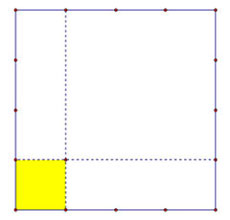
The bottom yellow square is 1/16 of the area of the original area.
We can see this by connecting the points dividing the sides of the
original square which shows us that the original square is cut into 16
different smaller
squares by these divisions. So, each one of these smaller squares is
1/16 the area of the
original square.
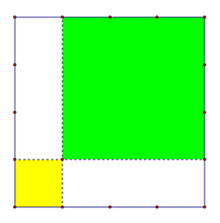 We also know that the larger green square formed by in the
above figure is 9/16 the area of the original square since, if we were
to form all of the divisions of the original square, the green square
would contain 9
of these smaller squares that are 1/16 the area of the original square.
We also know that the larger green square formed by in the
above figure is 9/16 the area of the original square since, if we were
to form all of the divisions of the original square, the green square
would contain 9
of these smaller squares that are 1/16 the area of the original square.
Now we will preform the second iteration of this process on the
larger of the two squares
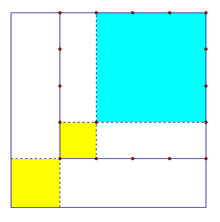
We can see that the smaller yellow square is 1/16 the area of the
original
green square,
which means it is (1/16)(9/16) the area of the original square. The
blue square is 9/16 the area of the original green square, which means
it is (9/16)(9/16) the area of the original square.
Now let's look at the fifth of these iterations.
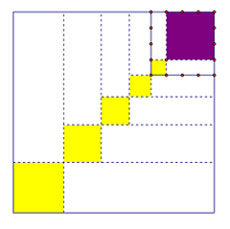 For this iteration, the small yellow square is 1/16 the area of our
fifth square which is (9/16)(9/16)(9/16)(9/16) since it is the fourth
division of our original square. So we must have that the small
yellow square is (1/16)(9/16)(9/16)(9/16)(9/16) the area of the
original square.
For this iteration, the small yellow square is 1/16 the area of our
fifth square which is (9/16)(9/16)(9/16)(9/16) since it is the fourth
division of our original square. So we must have that the small
yellow square is (1/16)(9/16)(9/16)(9/16)(9/16) the area of the
original square.
k=i-1
So it would appear from this investigation that the amount of shaded
area covered by the "corner squares" is ∑k=0(1/n2)[(n-1)2/n2](k-1)
where n is the number of divisions of the square and i is the number of
iterations.
Now we will check this formula. Using GSP we can find the area of
each square and see how much of the area of the large square is taken
up by the area of these smaller squares. We can then compare this
to the answer we find using our formula.
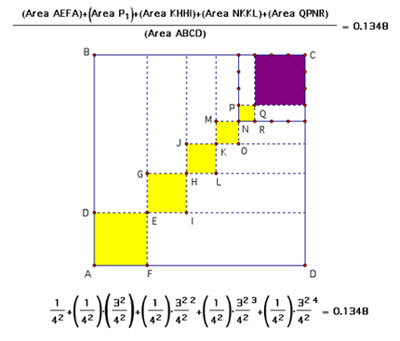
So we can see that using both methods provide us with the same result,
0.1348. Let's also look at another case. For this case we
make 8 divisions and will do 6 iterations.
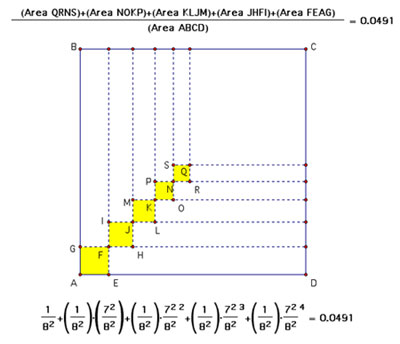
So we can see that using both methods provides us with the same result,
0.0491. So it appears that this formula does indeed work for this
case, and should work for any other case as well, but would this
formula also work for other figures? Let's investigate what
happens with a triangle.
How much area of a triangle is covered by an iteration of corner
triangles?
Let's start with a triangle ABC and trisect each side, shading the area
of the lower left hand triangle.
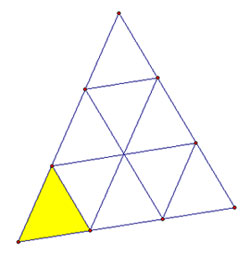
The large triangle is cut into 9 small triangles of equal area so the
yellow triangle is 1/9 the area of the original triangle.
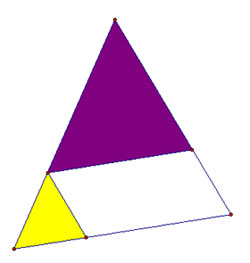
So we must also have that the purple triangle is 4/9 the area of the
original triangle since it contains 4 of the smaller 9 triangles from
our original triangle. Now we will divide the purple triangle
into smaller triangles.
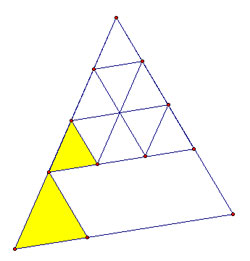
So by dividing this into smaller triangles we have that the small
yellow triangle is 1/9 the area of our purple triangle, therefore it is
(1/9)(4/9) the area of the original triangle. Now we will iterate
this process 7 times.

So we should have that each triangle is 1/9 the area of it's larger
triangle. So it would appear that the formula used for the
iteration of squares would work for triangles also since there are 3
divisions of each side. This would mean our n would be 3 and our
i would be 7. Let's use
GSP to investigate this hypothesis.
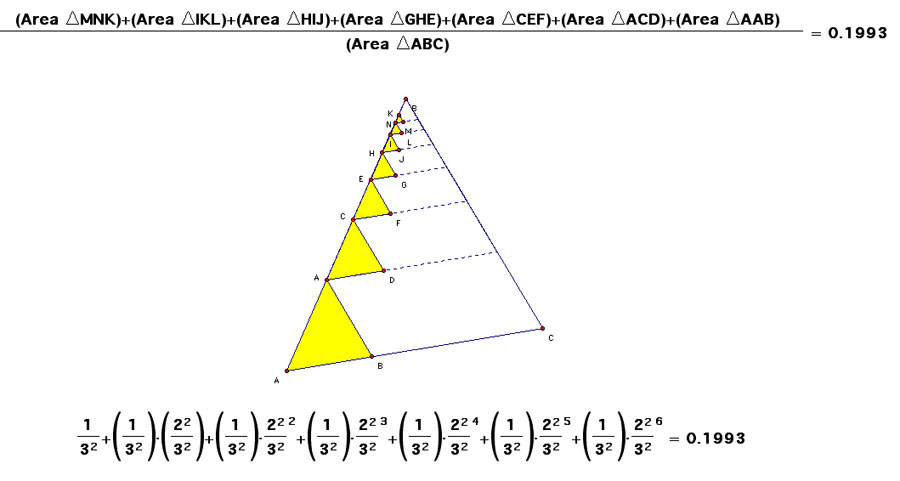
So it appears that the formula for squares works for triangles
also.
To see an interactive GSP sketch of the square iteration click here.
To see an interactive GSP sketch of the triangle iteration click here.











